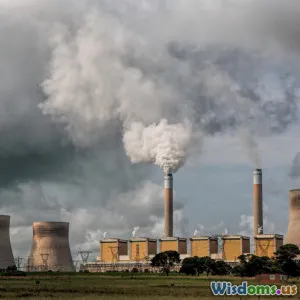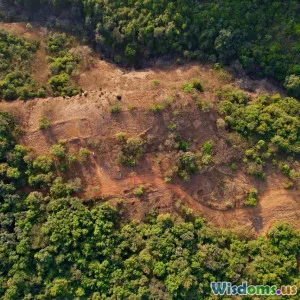
Ecosystem Restoration: A Path to Sustainability
7 min read Discover how ecosystem restoration drives sustainability, revitalizes nature, and combats climate change for a resilient future. (0 Reviews)
Ecosystem Restoration: A Path to Sustainability
Introduction
Imagine a world where barren landscapes bloom once again, forests regrow to provide life-giving oxygen, and degraded waterways teem with biodiversity. Ecosystem restoration is not just a hopeful dream—it’s an urgent necessity. As we face unprecedented environmental threats, this process offers a scientifically proven path to rebuilding the health of our planet. Ecosystem restoration stands at the forefront of sustainability efforts, promising not only to reverse environmental degradation but to create resilient systems that support both nature and humanity.
Understanding Ecosystem Restoration
At its core, ecosystem restoration involves revitalizing damaged or destroyed natural environments to a stable, healthy, and sustainable state. It goes beyond just planting trees; it is about restoring the intricate web of ecological relationships so the environment can renew itself and continue providing vital ecosystem services.
According to the United Nations Environment Programme (UNEP), over 2 billion hectares of degraded lands worldwide could be restored. This includes forests, wetlands, grasslands, and coral reefs. The diversity of ecosystems means that restoration techniques are equally varied—ranging from reforestation to wetland rehabilitation and coral gardening.
Why Ecosystem Restoration Matters
- Biodiversity recovery: Ecosystems support millions of species. Restoring them helps prevent extinctions and preserves genetic diversity.
- Climate change mitigation: Healthy ecosystems capture and store carbon, reducing greenhouse gases in the atmosphere.
- Sustainable livelihoods: Many communities rely on natural resources for food, medicine, and income.
- Disaster risk reduction: Restored wetlands and mangroves, for example, buffer storms and floods.
Key Drivers Behind Ecosystem Degradation
Before restoration, understanding the causes of degradation is crucial:
- Deforestation for agriculture and urban expansion
- Pollution and industrial waste
- Overfishing and unsustainable harvesting
- Climate change impacts such as droughts and temperature shifts
- Invasive species disrupting native habitats
These pressures gradually erode ecosystem functions, reducing biodiversity and community resilience.
Approaches to Ecosystem Restoration
1. Passive Restoration
In many cases, simply removing human pressures lets nature recover by itself. For example, the Chernobyl Exclusion Zone in Ukraine has seen a remarkable resurgence of wildlife and forest ecosystems once human activity ceased.
2. Active Restoration
Active techniques are necessary when ecosystems are severely degraded. Actions include planting native trees, reintroducing wildlife, soil decontamination, and rebuilding aquatic habitats.
Case Study: The Loess Plateau, China
Once highly eroded and barren, the Loess Plateau underwent intensive restoration combining tree planting, terracing, and sustainable agriculture. Since the 1990s, vegetation cover increased by over 50%, leading to improved livelihoods, reduced soil erosion, and enhanced local climate conditions.
3. Assisted Natural Regeneration
This approach involves protecting existing natural regeneration areas from threats like grazing or fires, accelerating ecosystem recovery in a cost-effective way.
4. Marine Ecosystem Restoration
Coral reefs, seagrass beds, and mangroves are critical coastal systems. Techniques such as coral transplantation and mangrove reforestation have gained traction. For example, the Philippines' coral reef restoration programs have improved fish stocks and coastal protection.
Benefits and Impact of Ecosystem Restoration
Climate Resilience
Healthy ecosystems absorb vast amounts of carbon. For instance, intact forests capture approximately 30% of human-generated CO2 emissions annually. Restored peatlands can store even more carbon per hectare than forests.
Economic Gains
The World Bank estimates that every dollar invested in restoration returns at least $7 in ecosystem services, including clean water, food security, and tourism.
Social Well-being
Restored ecosystems provide resources vital to indigenous and rural communities. Forest restoration projects in Nepal have empowered local groups through participatory management and income from sustainable harvesting.
Enhancing Biodiversity
Restoration can reverse species decline. The re-establishment of native plants provides habitats for threatened animals. The American Bison's recovery from near extinction was partially due to habitat restoration.
Challenges and Solutions
Despite promising outcomes, restoration faces hurdles:
- Funding limitations: Large-scale projects require substantial investment.
- Land tenure issues: Conflicting ownership can impede efforts.
- Technical knowledge: Inadequate site-specific ecological understanding may cause failures.
- Community Engagement: Lack of local involvement can lead to unsustainable practices post-restoration.
Innovative partnerships among governments, NGOs, scientists, and local communities have emerged as solutions. For example, the UN Decade on Ecosystem Restoration (2021-2030) aims to provide a global framework and mobilize funding.
How Individuals Can Contribute
- Supporting organizations dedicated to restoration
- Promoting sustainable land-use practices
- Participating in local tree planting and conservation projects
- Advocating for policies that prioritize environment and sustainability
Conclusion
Ecosystem restoration is a powerful beacon of hope in our fight against environmental degradation and climate change. It reconnects humanity with nature’s cycles, fosters biodiversity, mitigates carbon emissions, and nurtures resilient communities. The restored ecosystems we create today will stand as legacies for future generations. As the world comes together under initiatives like the UN Decade on Ecosystem Restoration, it’s clear that healing the planet’s wounds is both an ecological imperative and a pathway to sustainable prosperity.
The time to act is now—because restoring ecosystems means restoring balance, hope, and life itself.
“Restoring our ecosystems isn’t just a choice. It’s a necessity for our survival.” — Environmental Scientist Dr. Jane Goodall
Rate the Post
User Reviews
Popular Posts





















